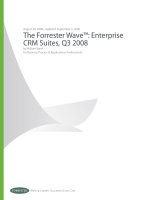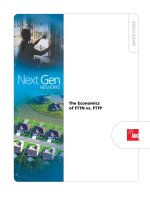Tài liệu The Forrester Wave™: Enterprise CRM Suites, Q3 2008 ppt
Bạn đang xem bản rút gọn của tài liệu. Xem và tải ngay bản đầy đủ của tài liệu tại đây (580.94 KB, 22 trang )
Making Leaders Successful Every Day
August 29, 2008 | Updated: September 2, 2008
The Forrester Wave™: Enterprise
CRM Suites, Q3 2008
by William Band
for Business Process & Applications Professionals
© 2008, Forrester Research, Inc. All rights reserved. Forrester, Forrester Wave, RoleView, Technographics, TechRadar, and Total Economic Impact
are trademarks of Forrester Research, Inc. All other trademarks are the property of their respective companies. Forrester clients may make one
attributed copy or slide of each figure contained herein. Additional reproduction is strictly prohibited. For additional reproduction rights and
usage information, go to www.forrester.com. Information is based on best available resources. Opinions reflect judgment at the time and are
subject to change. To purchase reprints of this document, please email
.
For Business Process & Applications Professionals
Includes a Forrester Wave™
EXECUTIVE SUMMARY
Forrester evaluated leading enterprise CRM suite solutions against 516 criteria and found that with the
latest releases of their solutions, Oracle’s Siebel and SAP maintain their status as Leaders with
comprehensive functionality and much improved usability. Microso, salesforce.com, RightNow, and
Oracle CRM On Demand have improved their credibility as enterprise-class solutions and have graduated
into the Leaders group. e latter vendors all get high marks for ease-of-use and quick time-to-value. e
Leaders are challenged by Strong Performers offering a diverse range of benefits. Oracle’s E-Business Suite
CRM and PeopleSo CRM are good options for their respective ERP customers looking for end-to-end
integration. Chordiant, ciboodle, and Pegasystems offer business process management (BPM) strengths to
help enterprises orchestrate complex customer-facing processes. Infor CRM Epiphany and Onyx CRM are
working to regain market momentum through investments in product enhancements being made by their
respective new corporate parents, Infor and Consona. Amdocs finds success with buyers as a Contender
solution for service-intensive industries with custom needs, such as telecommunications.
TABLE OF CONTENTS
The CRM Solution Landscape Is Increasingly
Complex
Enterprise CRM Suites Evaluation Overview
The Results: Enterprise Buyers Have Many
Choices To Sift Through
Vendor Profiles
Supplemental Material
NOTES & RESOURCES
In Q2 2008, Forrester evaluated 35 CRM
solutions. In the CRM enterprise suites category,
Forrester surveyed 10 CRM vendors, comprising
14 products: Amdocs, Chordiant Software,
ciboodle, Consona, Infor, Microsoft, Oracle
(E-Business Suite CRM, PeopleSoft CRM, Siebel
CRM, and Oracle CRM On Demand products),
Pegasystems, RightNow Technologies, salesforce.
com, and SAP. We also surveyed 165 vendor
customers.
Related Research Documents
“Topic Overview: Customer Relationship
Managemen
t”
March 25, 2008
“Forrester’s Best Practices Framework for CRM”
August 27, 2007
August 29, 2008 | Updated: September 2, 2008
The Forrester Wave™: Enterprise CRM Suites, Q3
2008
Buyers Face Difficult Choices In A Crowded Market
by William Band
with Sharyn C. Leaver, Pete Marston, Natalie L. Petouhoff, Ph.D., Elisse Gaynor, and Andrew
Magarie
2
6
10
12
18
xx
©
2008, Forrester Research, Inc. Reproduction ProhibitedAugust 29, 2008 | Updated: September 2, 2008
The Forrester Wave™: Enterprise CRM Suites, Q3 2008
For Business Process & Applications Professionals
2
THE CRM SOLUTION LANDSCAPE IS INCREASINGLY COMPLEX
Since our last iteration of the Forrester Wave™ evaluation of CRM enterprise suites, the vendor
solution space has continued to change in ways that makes choosing the right solution for your
organization an even more complicated decision.
The Cast Of CRM Characters Continues To Evolve
e CRM applications vendor space has gone through a period of considerable turmoil during the
past 36 months. e dust is still settling as the vendors continue to jockey for position in a market
expected to grow by more than 25% from $8.6 billion in 2007 to $10.9 billion by 2010.
1
What does
this all mean for CRM business process and applications professionals? To make the right CRM
solution investment and/or application upgrade decisions, you must navigate:
·
A revolving door of products and vendors. In a virtual game of capture the flag, larger players
have acquired smaller vendors to gain access to customers and fill in product gaps. For example,
Oracle completed its acquisition of PeopleSo in early 2005 and then swallowed Siebel in early
2006. SSA Global acquired Epiphany in August 2005 and was, in turn, acquired by Infor in mid-
2006. M2M Holdings acquired Onyx in August 2006, renamed itself Consona, and then acquired
KNOVA in March 2007. In April 2007, CDC Soware acquired Saratoga Systems, and in April
2008, Graham Technology become part of the Sword Group and was rebranded as ciboodle.
·
More choices for enterprise-class organizations. CRM vendors that have traditionally served
midmarket organizations are using modern architectures and new deployment options to gain a
stronger foothold with enterprise-class organizations. Examples include Consona’s Onyx CRM —
which offers a flexible, business process-centric architecture — and RightNow Technologies and
salesforce.com, which are pioneering CRM SaaS deployment. Microso is trying to exploit its
desktop applications hegemony advantage in large enterprises and promote its now more robust
business applications to this sector.
2
Chordiant Soware and Pegasystems are gaining traction
with CRM capabilities that leverage underlying business process management (BPM) platforms
and advanced customer-interaction rules and business intelligence.
·
Different approaches to improved usability. is desire for more user-friendly applications
is driving interest in CRM application upgrades as vendors make better UIs available in new
releases. For example, the new UI for SAP CRM 2007 has been completely re-architected to
support varying user roles and has “iGoogle”-like flexibility, with drag-and-drop personalization
embedded across the entire solution. e Oracle Siebel 8.1 UI can also be highly personalized,
uses embedded analytics, and is task-driven. And the Microso Dynamics CRM look-and-feel
itself resembles a familiar tool: Microso Office Outlook.
·
SaaS and open source options and challenges. As of late 2007, SaaS adoption by large
enterprises is now is 16%, up sharply from the previous year’s 12%, and CRM is one of the
©
2008, Forrester Research, Inc. Reproduction Prohibited August 29, 2008 | Updated: September 2, 2008
The Forrester Wave™: Enterprise CRM Suites, Q3 2008
For Business Process & Applications Professionals
3
categories of highest interest for SaaS buyers.
3
Vendors like BLUEROADS, NetSuite, RightNow
Technologies, and salesforce.com have pioneered as SaaS pure plays, and now traditional CRM
vendors have responded with their own SaaS offerings like Siebel’s — now Oracle’s — CRM On
Demand and SAP’s CRM on-demand solution. Microso now offers a SaaS option, Microso
Dynamics CRM Online. Sage Soware offers SageCRM as both an on-premise and SaaS
solution, and SugarCRM now offers a SaaS version of its open source solution development
model.
4
In fact, many CRM vendors now offer a variety of “on-demand” deployment models:
multi-tenancy, private hosting, and hosting of traditional on-premise solutions. Some also offer
“hybrid” deployment: a SaaS solution integrated with an on-premise version.
·
New approaches to upgrading customer data integration (CDI) and intelligence. By
combining operational data, streamlining customer data management processes, and presenting
a single view of the customer, CDI allows CRM professionals to manage compliance, improve
customer interaction efficiencies, and focus on customer experience management. For instance,
retailers and financial services firms that rely on data from many source systems use CDI
soware from DWL and Oracle to consolidate and deliver customer information to and from
call centers, branch offices, back-end administrative systems, and Web sites to support cross-
sell and upsell activities.
5
e importance being placed by vendors on enhancing their data
integration and business intelligence capabilities is underscored by SAP’s late 2007 acquisition of
Business Objects and Oracle’s early 2008 acquisition of Hyperion.
·
Various mobile CRM solutions — with different price tags. In a recent survey, we found that
nearly 50% of enterprises were piloting, rolling out, or currently using mobile applications for
sales. Similarly, more than 40% of small and medium-size businesses (SMBs) were piloting,
rolling out, or were using mobile applications to support their sales apps. Many CRM vendors
offer mobile sales solutions as extensions of their CRM applications.
6
Cross-market solution
providers like Microso, Oracle, salesforce.com, and SAP offer apps that can be used on
handhelds as part of their CRM solutions. Midmarket-centric vendors like FrontRange Solutions
(with its GoldMine offering), Maximizer Soware, and Sage Soware also offer solutions that
work on a variety of handheld devices. ese handheld sales solutions are natural extensions of
the CRM applications that the vendors provide. But sales and IT leaders still struggle to
understand the complexities of the vastly different mobile sales options and architectures.
·
Emerging social consumer behavior. CRM professionals must find innovative ways to engage
with emerging “social consumers”, enrich the customer experience through community-based
interactions, and architect solutions that are flexible and foster strong
intra-organization and
customer collaboration.
7
is new trend has number of names: CRM 2.0, social CRM, and
collaborative CRM. Vendors like Oracle’s Siebel and Oracle CRM On Demand are just now
starting to offer solution enhancements based on social technologies. SAP has plans to enhance
its use of social technology solutions for CRM, and Chordiant offers “Chordiant Mesh”, a
collaborative — social — environment for working closely with its own customers.
©
2008, Forrester Research, Inc. Reproduction ProhibitedAugust 29, 2008 | Updated: September 2, 2008
The Forrester Wave™: Enterprise CRM Suites, Q3 2008
For Business Process & Applications Professionals
4
·
Niche solutions to fill gaps. Notwithstanding the trend toward consolidation of CRM vendors
into suite solutions, specialty players continue to innovate by offering new functionality for
special requirements — for example, BLUEROADS offers partner channel management through
the SaaS deployment model. Additionally, in the contact center/eService sector, eGain, KANA,
KNOVA (acquired by Consona), and Talisma offer unique capabilities.
The Three Types Of CRM Vendors To Consider
As a buyer considering CRM solutions, you have three groups to choose from (see Figure 1):
·
Enterprise CRM suites. is category comprises vendor solutions primarily targeted toward
organizations with revenues of more than $1 billion per year and/or more than 1,000 employees.
CRM vendors focused on the enterprise-class organizations typically offer a full range of
functionalities, can scale to serve large user populations, and offer support for multiple languages
and countries. ey offer their products primarily through the traditional on-premise license
model. However, many of the leading players now also offer hosted and SaaS deployment options.
·
Midmarket CRM suites. is category comprises vendor solutions primarily targeted toward
the SMB market — organizations with revenues of less than $1 billion per year and/or less
than 1,000 employees. CRM vendors in this group also offer a breadth of CRM functionalities,
but these oen have more limited capabilities in specific areas and are simpler to use than
solutions built for the enterprise market. ese vendors are less suitable for large-scale global
deployments. Vendors in this group also offer a variety of deployment options, including on-
premise licensed, hosted, and SaaS. A number of vendors in this category have upgraded their
solutions to be more suitable to enterprise-class buyers and are gaining acceptance in that
segment as well.
·
CRM specialty tools. is category comprises vendors that offer solutions with narrow
functional breadth but deep specialty capabilities, for both enterprise and midmarket
organizations. Specialty CRM tools are available for marketing automation, sales force
automation (SFA), customer service, partner channel management and collaboration, customer
analytics, and customer data management.
©
2008, Forrester Research, Inc. Reproduction Prohibited August 29, 2008 | Updated: September 2, 2008
The Forrester Wave™: Enterprise CRM Suites, Q3 2008
For Business Process & Applications Professionals
5
Figure 1 Types Of CRM Solutions
Source: Forrester Research, Inc.
CRM specialty tools
Customer data management tools:
Customer service tools:
Marketing automation tools:
Sales force automation tools:
• CDC Software’s Saratoga
Pa
rtner channel management and
collaboration tools:
• BLUEROADS
• Click Commerce’s eCommerce Suite
• SPSS Predictive Analytics
Analytics tools:
Enterprise CRM suites
CRM suites appropriate for firms with revenues of
$1 billion a year or more and/or 1,000 employees
or more
Midmarket CRM suites
CRM suites appropriate for firms with revenues
less than $1 billion a year and/or less than
1,000 employees
• D&B Purisma’s Purisma Data Hub
• IBM InfoSphere MDM Serv
er
• Initiate Master Data Service
• Oracle’s Customer Data Hub
• Oracle’s Siebel Universal Customer Master
• SAP NetWeaver MDM
• SAS DataFlux’s CDI Solution
• Siperian MDM Hub
• Sun Master Data Management Suite
• Consona’s KNOVA Service Resolution
Management Suite
• eGain Serv
ice
• Genesys Telecommunications Lab’s CIM
Platform
• InQuira’s
Customer Experience Platform
• KANA Suite
• LivePe
rson’s Enterprise Platform
• Numara FootPrint’s for eService
• Talisma CIM
• Amdocs CES Customer Management
• Chordiant Software Cx Suite
• ciboodle
• Consona’s Onyx CRM*
• Info
r CRM Epiphany
• Microsoft Dynamics CRM*
• Oracle CRM On Demand*
• Oracle’s E-Business Suite CRM
• Oracle’s PeopleSoft CRM
• Oracle’s Siebel
• Pegasystems’ Customer Process Manager
• RightNow CRM*
• salesforce*
• SAP CRM
• CDC Software’s
Pivotal CRM
• Consona’s Onyx CRM*
• Entellium’s eSalesforce, Rave, eCustomer Center
• FrontRange Solutions’ GoldMine Enterprise Edition
• Maximizer CRM
• Microsoft Dynamics CRM*
• NetSuite
• Oracle CRM On Demand*
• Oracle’s Siebel CRM Professional Edition
• RightNow CRM*
• Sage CRM
• Sage SalesLogix
• salesforce*
• Selligent X@
• Sugar Enterprise
• Alterian Marketing Suite
• Aprimo Enterprise
• SAS’ Customer Intelligence Platform
• Teradata Customer Management
• Unica’s Affinium Marketing Management
*These vendors have a significant base of both enterprise and midmarket customers.
©
2008, Forrester Research, Inc. Reproduction ProhibitedAugust 29, 2008 | Updated: September 2, 2008
The Forrester Wave™: Enterprise CRM Suites, Q3 2008
For Business Process & Applications Professionals
6
ENTERPRISE CRM SUITES EVALUATION OVERVIEW
To assess the state of the CRM market and see how the vendors stack up against each other, Forrester
evaluated the strengths and weaknesses of top CRM vendors — including enterprise suite and
midmarket suite vendors — across 516 criteria. We then applied two sets of criteria weightings: one
appropriate for large, enterprise-class deployments and another focused on midmarket priorities.
8
e following assessment will help you see how the 14 enterprise CRM suite products that we
evaluated stack up against each other.
Buyers Focus On Current Offering, Future Vision, And Strength Of Install Base
Aer examining past research, user need assessments, and vendor and expert interviews, we
developed a comprehensive set of evaluation criteria (see Figure 2). We evaluated vendors against
516 criteria, which we grouped into three high-level categories:
·
Current offering. We looked at the breadth of vendors’ product offering(s), global capabilities,
and adaptation to specific industry requirements. We evaluated vendor customer data
management abilities and usability, and took into consideration cost and the strength of vendors’
technology platform and tools.
·
Strategy. We looked at the strength of the vendors’ product strategy and vision and how they
intend to be leaders in the enterprise CRM market. An important set of criteria focuses on
the methods vendors use to deliver a satisfactory application ownership experience to their
customers and how long it takes customers to realize value from their solution.
·
Market presence. We gauged the size of the vendors’ customer base in the enterprise CRM
segment and evaluated the depth of human and financial resources available to enhance their
products and serve customers.
Vendors Offer A Breadth Of Capabilities For Complex Enterprises
We included 14 solutions in our assessment of enterprise CRM suites: Amdocs CES Customer
Manager, Chordiant Soware Cx Suite, ciboodle, Infor CRM Epiphany, Microso Dynamics CRM,
Onyx CRM, Oracle CRM On Demand, Oracle E-Business Suite CRM, Pegasystems Customer
Process Manager, PeopleSo CRM, RightNow CRM, salesforce, SAP CRM, and Siebel (see Figure 3).
Each of these vendors:
·
Offers a multifunctional CRM applications suite. Each vendor included in this Forrester
Wave has functionality in a minimum of three of the following CRM subdisciplines and tools:
marketing, sales force automation, customer service, field service, partner channel management,
eCommerce, customer analytics, and customer data management.
©
2008, Forrester Research, Inc. Reproduction Prohibited August 29, 2008 | Updated: September 2, 2008
The Forrester Wave™: Enterprise CRM Suites, Q3 2008
For Business Process & Applications Professionals
7
·
Targets large enterprises with complex requirements. e vendors we included focus on,
and have references with, enterprise-class organizations with complex requirements. ese
requirements include the ability to scale on a global basis, manage end-to-end business process,
integrate into complex legacy environments, and manage large volumes of customer and related
data.
·
Offers a product in now general release and use by customers.
e vendors we included have
a specific solution (release) that was generally available at the time of data collection for this
evaluation with at least three references available for contact.
Figure 2 Evaluated Vendors: Product And Selection Criteria
Source: Forrester Research, Inc.
Vendor
Amdocs
Chordiant Software
ciboodle
Co
nsona CRM
Info
r
Microsoft
Oracle
Oracle
Oracle
Oracle
Pegasystems
RightNow
Technologies
salesforce.com
SAP
Product evaluated
Amdocs CES Customer Management
Chordiant Software Cx Suite
ciboodle
Onyx CRM
Info
r CRM Epiphany
Microsoft Dynamics CRM
Oracle CRM On Demand
E-Business Suite CRM
PeopleSoft CRM
Siebel
Cu
stomer Process Manager
RightNow CRM
salesforce
SAP CRM
Produc
t version
evaluated
7.5
Chordiant FDN 6.1, MD, CDM
2.7
OEP 6.0
7
4.0
Release 15
R12
9.0
8.1
5.2.3
Fe
bruary ‘08
Summer ’08
SAP CRM 2007
Ve
rsion
release date
January 2008
December 2007
April 2008
September 2006
Ma
y 2008
December 2007
Mar
ch 2008
2007
August 2006
2008
April 2008
Fe
bruary 2008
Ma
y 2008
Mar
ch 2008
Ve
ndor selection criteria
The vendor offers a multifunctional CRM applications suite, comprising three or more CRM subdisciplines.
The vendor targets enterprise-class organizations with complex business requirements.
The solution was generally available at the time of data collection for this evaluation with at least three
references available for contac
t.









